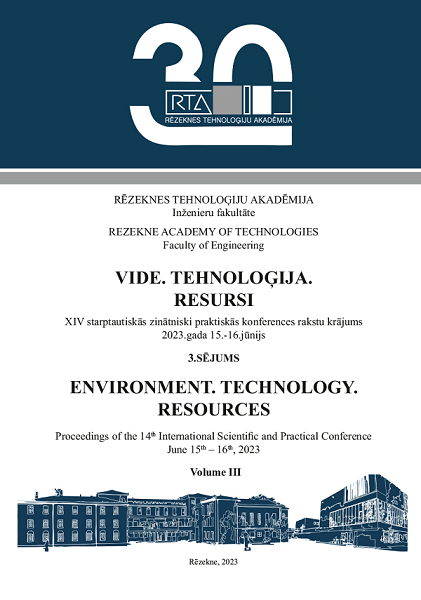INVESTIGATION OF LASER MARKING AND TEXTURING OF TITANIUM GR 2 WITH FIBER LASER
DOI:
https://doi.org/10.17770/etr2023vol3.7251Keywords:
Fiber laser, laser marking, laser texturing, laser parameter optimization, titaniumAbstract
Titanium Gr 2 is widely used in engineering and medicine due to its excellent mechanical and corrosion-resistant properties. Laser marking is a crucial process for many applications that require high-contrast, durable markings. In this study, we used a Rofin PowerLine F 20 Varia fiber laser to mark titanium Gr 2 with a 6x6 matrix of 5x5 mm squares. We varied the speed (100-1100 mm/s), power (8-18 W), and frequency (100 and 500 kHz) of the laser marking process to investigate their effects on the surface roughness and contrast of the markings. We analyzed the markings using a laser scanning microscope and Adobe Photoshop software. Our results show that the contrast and roughness of the markings were influenced by the frequency, scanning speed, and power. High marking speeds produced lighter markings, while low marking speeds produced darker markings. We also found that the surface roughness increased with higher frequency and powers. Our findings provide valuable insights into the optimal laser marking parameters for titanium Gr 2, which can enhance its performance and durability in various applications.
References
G. Annamaria un B. Massimiliano , «Laser polishing: a review of a constantly growing technology,» The International Journal of Advanced Manufacturing Technology (2022) 120:1433–1472, pp. 1.-7., 2022.
O. Galina , S. Nadezhda un L. Darya , «Prospects of "Colorit" Technology of Color Laser,» ResearchGate, pp. 2.-4., 2021.
M.-F. a. F. a. Francisca , G. Bruno, G. Michael , S. Filipe un M. Georgina, «Experimental analysis and predictive modelling of Ti6Al4V laser surface texturing for biomedical applications,» Surfaces and Interfaces volume 35, pp. 1.-9., December 2022.
C. W. Chung, S. P. Bhanu and T. H. Wen, "Coloring of titanium by CW fiber laser irradiation and infrared temperature measurement," Optics Communications, 1 february 2023.
J. Tahseen, W. Marc un D. Stefan, «Erasing and rewriting of titanium oxide colour marks using laser-induced reduction/oxidation,» Applied Surface Science Volume 458, pp. 849.-854., 15 November 2018.
B. Simas , J. Vytautas , K. Evaldas , S. Žilvinas , P. Domas un S. Valdas, «High-Contrast Marking of Stainless-Steel Using Bursts of,» Micromachines 14(1):194, pp. 1.-2., January 2023.
J. Tahseen, D. Sunan, B. Haider un D. S, «Laser induced single spot oxidation of titanium,» Applied Surface Science, pp. 617.-624., 30 November 2016.
G. Wenyan, X. Yafei, L. Guang, C. Chang, L. Benhai, H. Zhenxing, L. Kai un W. Junlong, «Investigations on the laser color marking of TC4,» Optik, pp. 11.-18., April 2019.
A. Yaroslava , L. Darya , M. Oleg un . L. V. C., «Laser coloration of metals in visual art and design,» ResearchGate, pp. 3.-6., March 2019.
A. D.P., M. R.D., S. D.J., H. D.A., R. M.A., K. P.G. un J. B.H., «Nanosecond pulsed laser irradiation of titanium: Oxide growth and effects on underlying metal,» ScienceDirect, pp. 38.-45., June 2014.
J. Tahseen, W. Marc un D. Stefan, «Erasing and rewriting of titanium oxide colour marks using laser-induced reduction/oxidation,» ScienceDirect, pp. 849.-854., 15 November 2018.
B. Matilde , L. Adrian H. A. , S. Corrado un R. Luca , «A Hybrid Approach to Surface Engineering Based on Laser,» Journal of Manufacturing and Materials Processing 7(2):59, pp. 3.-5., March 2023.
B. Salomé, H. Guillaume , P. H. Alina Pascale, B. Stéphane un V. Stéphane , «Effect of Texturing Environment on Wetting of Biomimetic Superhydrophobic Surfaces Designed by Femtosecond Laser Texturing,» ResearchGate, pp. 1.-6., 2022.
P. M. B. P. A.G. Demir, «Fibre laser texturing for surface functionalization,» Lasers in Manufacturing Conference 2013, pp. 763.-764., 2013.
L. Lyubomir, N. Pavels un D. Hristina, «Laser Marking Methods,» Technology. Resources, (2015), Volume I, 108-115, pp. 109,-112., 2015.
K. McLAREN, XIII—The Development of the CIE 1976 (L* a* b*) Uniform Colour Space and Colour-difference Formula, sēj. 92, Journal of the Society of Dyers and Colourists, 1976, pp. 338-341.
A. J. Arkadiusz, S. Bogusz, K. E. Paweł un A. M. Krzysztof, «The influence of process parameters on the laser-induced coloring,» Applied Physics A volume 115, pages1003–1013 (2014), March 2013.
Johnson, A. and Lee, S, « Influence of laser power and speed on the contrast and roughness of markings on titanium alloys,» Materials Science and Engineering: A, 764: 138214. (2020).
Smith, J., Williams, K., and Brown, P, «. Effect of laser marking parameters on titanium Gr 2 using a fiber laser,» Journal of Laser Applications, 27(2): 022503., February 2015.
Chen, C., Li, J., Wu, C., and Huang, X, « Effects of laser parameters on the microstructure and corrosion behavior of Ti6Al4V alloy laser remelted surface,» Applied Surface Science, volume 455, pages 514-523, July 2018.
Wang, Y., Wang, S., Dong, X., and Wu, Y, «. Effect of laser power on surface morphology and wettability of AZ31B magnesium alloy by laser surface texturing,» Optics and Laser Technology, volume 131: 106497., June 2020.



